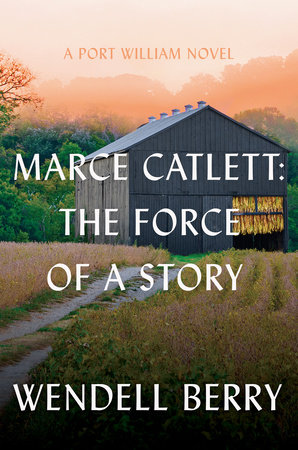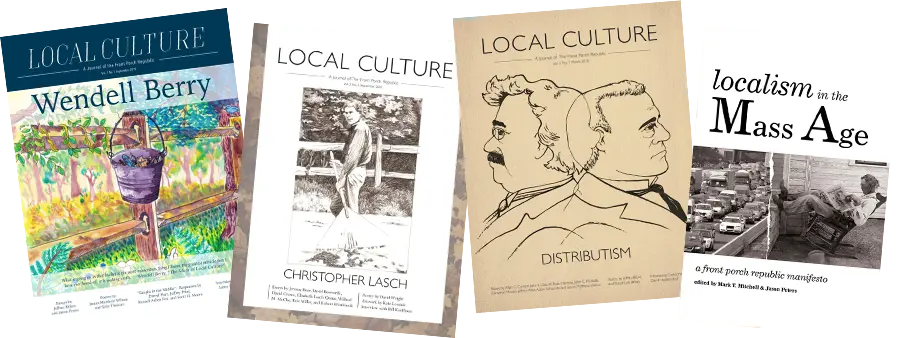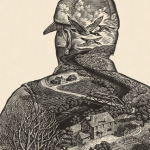Wendell Berry has written a ninth Port William novel, and it is unlike any other in the set.
The new novel’s title, Marce Catlett: The Force of a Story (Counterpoint, 2025), echoes four others that use a character’s name: Nathan Coulter (1960), Jayber Crow (2000), Hannah Coulter (2004), and Andy Catlett: Early Travels (2006). And like its predecessors, the new novel features its eponymous character as well as several other familiar Port William inhabitants.
That is about as far as the similarities go.
In prior novels that used a character’s name as the title, that character was the protagonist and the novel traced either their full life or at least a formative era. Marce Catlett breaks that pattern. Marce (as an embodied character) is the center of the novel’s plot for only the first twenty-five-or-so pages. And those pages give an account of not much more than twenty-four hours in his life.
It is the story distilled from those hours—the events that occurred during the interval, their lasting significance and weight, and the remembering of them—that connects the novel’s various pieces.
The story itself is simple, and one that is known by avid (and perhaps even casual) readers of Berry: Marce Catlett travels to Louisville early in 1907 to be present for the sale of his 1906 crop of tobacco. For it he receives “nothing”—the crop’s “purchase, properly named, was theft.” As Marce explains to his wife (within the hearing of his son Wheeler), “It brought just a little short of what it cost to sell it.”
It is the story distilled from those hours—the events that occurred during the interval, their lasting significance and weight, and the remembering of them—that connects the novel’s various pieces.
After describing the events in their original 1907 setting, the novel turns its attention to the survival of the Catletts and of the story, which, as the subtitle suggests, operates as a force in the lives of Marce and his descendants as well as in the history of Port William. Marce Catlett asks two linked questions—
What is the force of such a story? What is its meaning?
—and offers at least three different responses to that pair of questions.
I. The story tells readers something about Marce Catlett and his pattern of farming. Marce comes through this tragedy in part because he is resolute. Immediately after sharing the disastrous news, he says to his wife, “Dorie, it’ll be all right. I’ll do what it takes to make it all right.”
Just as important as his determination, Marce’s farming obeys “the rule of diversity.” His farm produces many things, including much of what his family consumes. Such subsistence, coupled with thrift and caution, enable Marce and his family to carry on. In this regard, Berry’s new novel incorporates familiar agrarian themes and in so doing preserves a snapshot of and a justification for “the customs and refined skills of dwelling at home.”
II. The novel also meditates upon the power of stories in general. Marce’s experience becomes a shared memory that reminds the Catletts who they are and where they are.
In tracing the story’s effects after and beyond Marce, Berry writes, “So Marce remembered [the story] to Wheeler, who told it to Andy, who in a world radically changed needed a long time and great care to imagine what he heard, but as he has imagined it he has passed it on to his children, for the story has been, as it is still, a force and a light in their place.”
And, elsewhere in the book: “The story and the love borne in it, passing down, has held [the Catletts] together like a living root of the same tree, and like a tuned string, across a hundred and eighteen years and five generations.”
Berry recognizes two sides of such continuity: a story like what happened to Marce is required to hold a family in place across generations, but that perseverance is nevertheless remarkable given how easily that string could have fallen out of tune or been broken. Indeed, Marce Catlett includes the stories of two different Catlett men returning home, despite the opportunity for a “better life” somewhere else: Wheeler declining an office job in Chicago and Andy’s own homecoming to Port William.
Versions of the same homecomings can be found in Remembering (1988). Marce Catlett also ruminates on the life and killing of Andy’s uncle Andrew—the focus of A World Lost (1996).
What is different in Berry’s new novel is the way it prioritizes the “life” of one particular story rather than any human character. A single story from Marce’s life is more central to the novel bearing his name than he is. And though Andy’s life and mind are integral to the novel (as they are to much of Berry’s fiction), Andy, too, is less central to the novel than the story itself is. Depending on one’s taste in fiction, the novel’s focus on the formation and survival of a single, brief story makes Marce Catlett either odd or inventive.
III. What is most certainly odd about the novel is the degree to which it reads, occasionally, as nonfiction. Marce Catlett, then, represents Berry’s continuing disinterest in the formal boundaries of fiction, apparent earlier in The Art of Loading Brush (2017). In the introduction to that volume, Berry described “The Order of Loving Care” as a short story in which “one fictional character, Andy Catlett, . . . encounters and learns from a number of my own ‘real life’ friends and teachers.”
Berry called that story “peculiar”—a label I feel comfortable applying to Marce Catlett given the frequent and specific historical references included in the novel.
The source of the “wound” and “insult” given to Marce in 1907 is named specifically at least three times in the novel—first as “the monopoly of James B. Duke’s American Tobacco Company” and later as “the Duke monopoly” and “the American Tobacco Company of James Buchanan Duke.”
The novel also reconstructs the history of the Burley Tobacco Growers Co-operative Association—created by those who remembered “the calamity of the 1906 tobacco crop,” later reorganized under “Roosevelt’s New Deal,” and eventually “ended at last by the so-called conservatism that had always opposed it.”
The novel portrays Marce’s story as a catalyst for Wheeler’s involvement in shaping the tobacco program: “It might be argued that this story . . . was the force that made the Burley Tobacco Growers Co-operative Association. That program was embodied, and for decades maintained, by rememberers like Wheeler, who had witnessed and remembered in their hearts the effects of corporate plunder and indifference.”
Marce Catlett also manages to map (in broad strokes) the effects of industrialization upon farming communities over the past 80 years and to detail the (on average) 460 hours spent on an acre of tobacco across a single year.
All of this material gave me the feeling that I was reading Berry’s nonfiction—or that I was slipping back and forth between a novel and an essay.
All of this material gave me the feeling that I was reading Berry’s nonfiction—or that I was slipping back and forth between a novel and an essay. As did this quotation: “The good, frugal farmers of Port William were entering, without knowing it, the technological romance of the corporate giants, the millionaires and billionaires, who would conquer the earth, conquer ‘space,’ invade Mars, a place better known to them than the country that grows their food. (This is now a policy of the second Trump Administration).”
But for the mention of “Port William,” those sentences would fit snugly in several of Berry’s essays.
I won’t hazard a guess about why Berry is narrowing the gap between his fiction and nonfiction. The resulting effect, I think, is a “novel” that is more urgent than Berry’s others. Marce’s story, as packaged in the novel, delivers a forceful critique of corporate power and greed—in 1907 and, arguably, 2025.
The novel’s message about our own time is stark. The tobacco program has been gone for decades. The vacuum created by the loss of the crop and its attendant human culture has led to most country people whose ancestors depended on it being folded into and subdued by an urban economy.
What hope there might be, the novel suggests, exists in remembering: agricultural programs built on production controls and price supports and orchestrated by local leaders with allies in state capitols and Washington D.C. Any such programs, however, depend on remembering stories like Marce’s.
The novel ends with a final memory: a detailed recollection of a space on the Catlett homeplace that I don’t recall seeing described with such care before. The space is humble, common, and mentioned by name frequently in Berry’s novels and short stories. The building, according to Berry, was “an elegant reconciliation of art and nature.” Built of native materials, it served a vital role in Andy’s grandparents’ household economy and was also beautiful. But “in the age of the bulldozer it was in the way”; in the today of the novel it is gone.
What are we to do with this memory of a stone-walled cellar? What force will its story exert? Berry’s rendering of it is clearly symbolic and, for me, surprisingly moving (I never saw the cellar or one like it, but still mourned its loss). I am quite sure that some (and probably many) will say of Berry that he is, once again, reveling in nostalgia. But nostalgia, especially for something many of us never knew, is surely not the point. The loss of the cellar is not sad merely because the cellar was old: its destruction is shameful because the thing was useful and beautiful. Berry knows that he will not live into a time when America’s rural places are again prosperous reconciliations of art and nature. But he has given us stories whose memories, if acted on in our places, might bloom in new and unforeseeable reconciliations. His Port William fiction challenges us to share in the vision that animated Marce, Wheeler, and Andy: the “shared vision of a life permanently settled in a place chosen and beloved.”
Image via Pexels.






